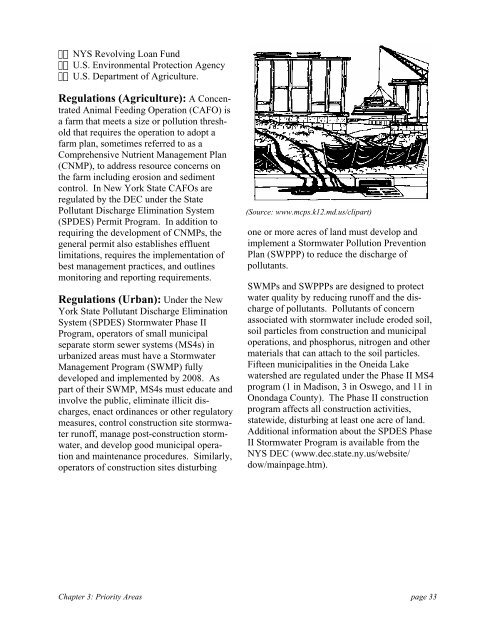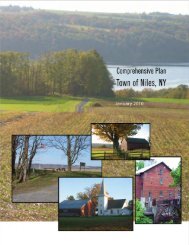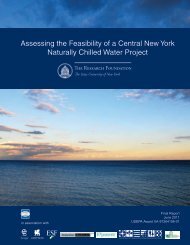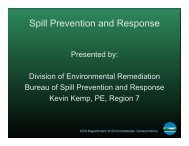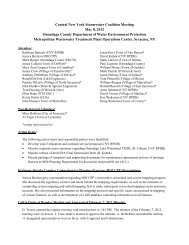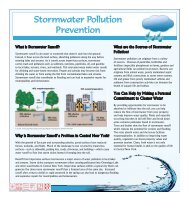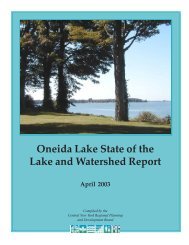A Management Strategy for Oneida Lake and its ... - CNY RPDB Home
A Management Strategy for Oneida Lake and its ... - CNY RPDB Home
A Management Strategy for Oneida Lake and its ... - CNY RPDB Home
Create successful ePaper yourself
Turn your PDF publications into a flip-book with our unique Google optimized e-Paper software.
•NYS Revolving Loan Fund<br />
•U.S. Environmental Protection Agency<br />
•U.S. Department of Agriculture.<br />
Regulations (Agriculture): A Concentrated<br />
Animal Feeding Operation (CAFO) is<br />
a farm that meets a size or pollution threshold<br />
that requires the operation to adopt a<br />
farm plan, sometimes referred to as a<br />
Comprehensive Nutrient <strong>Management</strong> Plan<br />
(CNMP), to address resource concerns on<br />
the farm including erosion <strong>and</strong> sediment<br />
control. In New York State CAFOs are<br />
regulated by the DEC under the State<br />
Pollutant Discharge Elimination System<br />
(SPDES) Permit Program. In addition to<br />
requiring the development of CNMPs, the<br />
general permit also establishes effluent<br />
limitations, requires the implementation of<br />
best management practices, <strong>and</strong> outlines<br />
monitoring <strong>and</strong> reporting requirements.<br />
Regulations (Urban): Under the New<br />
York State Pollutant Discharge Elimination<br />
System (SPDES) Stormwater Phase II<br />
Program, operators of small municipal<br />
separate storm sewer systems (MS4s) in<br />
urbanized areas must have a Stormwater<br />
<strong>Management</strong> Program (SWMP) fully<br />
developed <strong>and</strong> implemented by 2008. As<br />
part of their SWMP, MS4s must educate <strong>and</strong><br />
involve the public, eliminate illicit discharges,<br />
enact ordinances or other regulatory<br />
measures, control construction site stormwater<br />
runoff, manage post-construction stormwater,<br />
<strong>and</strong> develop good municipal operation<br />
<strong>and</strong> maintenance procedures. Similarly,<br />
operators of construction sites disturbing<br />
(Source: www.mcps.k12.md.us/clipart)<br />
one or more acres of l<strong>and</strong> must develop <strong>and</strong><br />
implement a Stormwater Pollution Prevention<br />
Plan (SWPPP) to reduce the discharge of<br />
pollutants.<br />
SWMPs <strong>and</strong> SWPPPs are designed to protect<br />
water quality by reducing runoff <strong>and</strong> the discharge<br />
of pollutants. Pollutants of concern<br />
associated with stormwater include eroded soil,<br />
soil particles from construction <strong>and</strong> municipal<br />
operations, <strong>and</strong> phosphorus, nitrogen <strong>and</strong> other<br />
materials that can attach to the soil particles.<br />
Fifteen municipalities in the <strong>Oneida</strong> <strong>Lake</strong><br />
watershed are regulated under the Phase II MS4<br />
program (1 in Madison, 3 in Oswego, <strong>and</strong> 11 in<br />
Onondaga County). The Phase II construction<br />
program affects all construction activities,<br />
statewide, disturbing at least one acre of l<strong>and</strong>.<br />
Additional in<strong>for</strong>mation about the SPDES Phase<br />
II Stormwater Program is available from the<br />
NYS DEC (www.dec.state.ny.us/website/<br />
dow/mainpage.htm).<br />
Chapter 3: Priority Areas page 33


